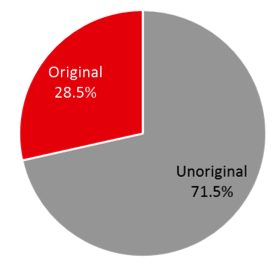Kawazunga Arbargle! Or how to boost your click rate by 34%
Subject lines… the easiest thing to write, the hardest thing to get right. There is just no single rule, tactic or word that works every time. Best practices sometimes fail and A/B testing can produce unexpected results.
Why is this? In simplest terms, being original keeps your subscribers on their toes and can spark in-actives into life. But if every subject line you write is surprising and original, your subscribers catch on and that lack of clarity has a negative effect.
So the key is originality in moderation. But how much originality and how much moderation?
Email marketers are not very original Alchemy Worx analysed half a billion sent messages from 15 of their
Alchemy Worx analysed half a billion sent messages from 15 of their
largest clients across multiple industries to see what they could find.
They categorized each subject line as unoriginal and original
– original being a subject line that contained at least one word
the sender had never used before.
You might think that with such a conservative definition for
originality most marketing emails would be classified as original.
But as the pie chart shows, less than a third were classified as original.
Original subject lines boost click rates
So what effect does originality (or unoriginality) have on open and click rates? The results are below:

While we only see a modest increase in open rates when using original words, we see a significant lift – 34% – in the unique click rate. What’s happening?
Using new and original subject lines triggers an entirely different subset of subscribers to open your emails. Many occasional or non-openers take a chance and open your email because they don’t recognize it from the subject line - “Oh, this doesn’t look like the weekly newsletter I usually avoid”.
We also know through tracking open reach that an open from an occasional or non-opener is much more likely to produce a click in an email, so the click rate goes up.
This also explains why the open rate does not increase as much as the click rate because the opposite behaviour is true of regular, multiple openers. The subscriber who diligently opens every weekly newsletter might miss this one if it’s not labelled as such. But that’s okay, because they will just open the next one.
Originality is relative
Defining originality depends on your current email strategy, previous subject lines and on what is happening in your subscribers’ inbox. Using a word once a year might be deemed unoriginal for a monthly newsletter but very rare for a daily deals send.
When everyone in the industry is following the same rules, don’t just follow blindly (never use “free” is a classic example). The specific combination of an original word and your list is what’s important.
So define your originality and next time you want to reactivate your in-actives or boost your clicks, get out of your comfort zone and try something new.
Five quick tips for finding original subject line words
- Run a quick word frequency analysis of your own subject lines to see which words you use most and which you never use.
- Use a thesaurus, it’s a writer’s best friend and can instantly give you dozens of new ways to say the same thing
- Take inspiration from elsewhere - we often try and use a Word of the Day in our subject lines to trigger a chain of creativity (e.g. Enjoy a peculiar 21% saving).
- Use a dictionary definition of a word, instead of the word itself (e.g. look at all the potential original words found in the dictionary definition of Sale (noun) – an event at which goods are sold at reduced prices, usually to clear old stocks)
- Try the subject line tool Touchstone to predict the performance of your original subject lines before you click send. It gives you word recommendations, too.
When you subscribe to the blog, we will send you an e-mail when there are new updates on the site so you wouldn't miss them.

 How to resolve AdBlock issue?
How to resolve AdBlock issue? 